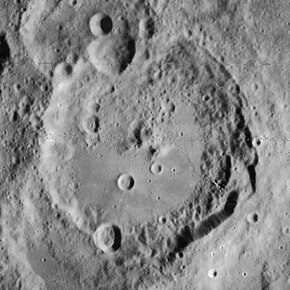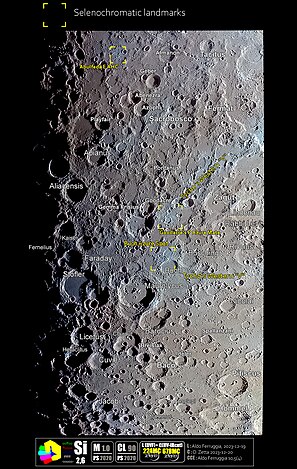 Lunar Orbiter 4 image Lunar Orbiter 4 image | |
| Coordinates | 41°48′S 14°00′E / 41.8°S 14.0°E / -41.8; 14.0 |
|---|---|
| Diameter | 114 km |
| Depth | 4.7 km |
| Colongitude | 345° at sunrise |
| Eponym | Francesco Maurolico |
| This article includes a list of general references, but it lacks sufficient corresponding inline citations. Please help to improve this article by introducing more precise citations. (October 2022) (Learn how and when to remove this message) |
Maurolycus is one of the more prominent lunar impact craters in the southern highland region of the Moon that is covered in overlapping crater impacts. It was named after 16th century Italian mathematician Francesco Maurolico. It is joined at the southeast rim by the smaller crater Barocius. Due west lie the overlapping pair of Stöfler and Faraday. To the northeast is the faint crater Buch, and further to the north lies Gemma Frisius.
The outer walls of Maurolycus are tall, wide, and terraced, most notably in the eastern part. To the southeast the rim is lower and the crater is joined to what has the appearance of an overlain crater rim. The crater Maurolycus F lies across the northwest rim, and that part of the crater floor is more rugged than the remainder. The other sections of the floor are relatively level, with a complex of central peaks and a pair of craterlets. The small crater Maurolycus A is biting into the southern part of the rim.

Satellite craters

By convention these features are identified on lunar maps by placing the letter on the side of the crater midpoint that is closest to Maurolycus.
| Maurolycus | Latitude | Longitude | Diameter |
|---|---|---|---|
| A | 43.5° S | 14.2° E | 15 km |
| B | 40.3° S | 11.7° E | 12 km |
| C | 38.6° S | 10.8° E | 9 km |
| D | 39.0° S | 13.2° E | 45 km |
| E | 38.4° S | 9.8° E | 6 km |
| F | 40.6° S | 12.2° E | 25 km |
| G | 44.4° S | 11.5° E | 7 km |
| H | 38.2° S | 10.4° E | 7 km |
| J | 42.5° S | 14.0° E | 9 km |
| K | 40.0° S | 12.6° E | 8 km |
| L | 42.1° S | 14.5° E | 6 km |
| M | 41.9° S | 12.6° E | 10 km |
| N | 41.0° S | 14.1° E | 7 km |
| P | 38.1° S | 12.8° E | 4 km |
| R | 40.7° S | 16.2° E | 5 km |
| S | 42.0° S | 17.1° E | 7 km |
| T | 41.3° S | 11.4° E | 10 km |
| W | 42.7° S | 15.2° E | 4 km |
References
- "Maurolycus (crater)". Gazetteer of Planetary Nomenclature. USGS Astrogeology Research Program.
- Andersson, L. E.; Whitaker, E. A. (1982). NASA Catalogue of Lunar Nomenclature. NASA RP-1097.
- Bussey, B.; Spudis, P. (2004). The Clementine Atlas of the Moon. New York: Cambridge University Press. ISBN 978-0-521-81528-4.
- Cocks, Elijah E.; Cocks, Josiah C. (1995). Who's Who on the Moon: A Biographical Dictionary of Lunar Nomenclature. Tudor Publishers. ISBN 978-0-936389-27-1.
- McDowell, Jonathan (July 15, 2007). "Lunar Nomenclature". Jonathan's Space Report. Retrieved 2007-10-24.
- Menzel, D. H.; Minnaert, M.; Levin, B.; Dollfus, A.; Bell, B. (1971). "Report on Lunar Nomenclature by the Working Group of Commission 17 of the IAU". Space Science Reviews. 12 (2): 136–186. Bibcode:1971SSRv...12..136M. doi:10.1007/BF00171763. S2CID 122125855.
- Moore, Patrick (2001). On the Moon. Sterling Publishing Co. ISBN 978-0-304-35469-6.
- Price, Fred W. (1988). The Moon Observer's Handbook. Cambridge University Press. ISBN 978-0-521-33500-3.
- Rükl, Antonín (1990). Atlas of the Moon. Kalmbach Books. ISBN 978-0-913135-17-4.
- Webb, Rev. T. W. (1962). Celestial Objects for Common Telescopes (6th revised ed.). Dover. ISBN 978-0-486-20917-3.
- Whitaker, Ewen A. (1999). Mapping and Naming the Moon. Cambridge University Press. ISBN 978-0-521-62248-6.
- Wlasuk, Peter T. (2000). Observing the Moon. Springer. ISBN 978-1-85233-193-1.
External links
- Wood, Chuck (November 10, 2006). "Flows & Falling Rock". Lunar Photo of the Day. Archived from the original on September 29, 2007. Retrieved 2006-11-10.